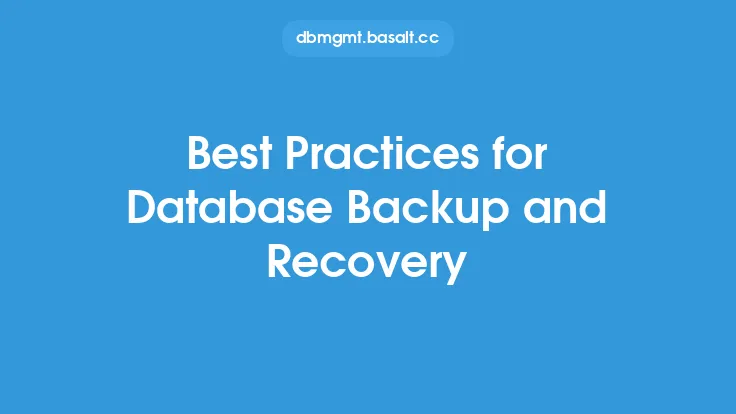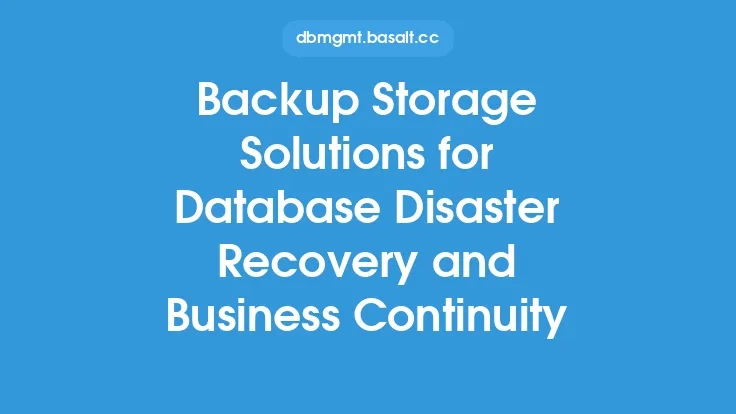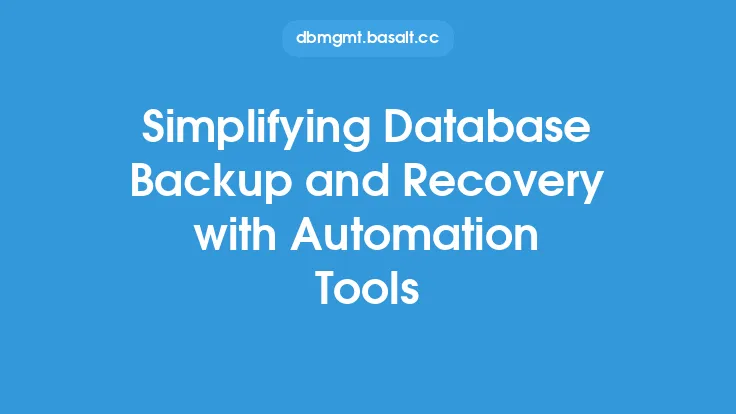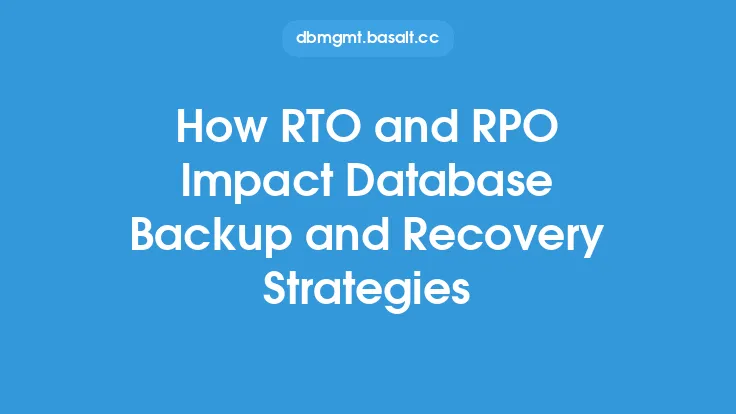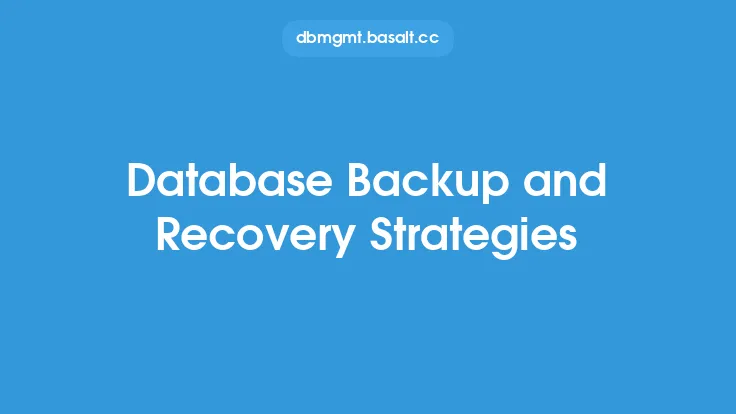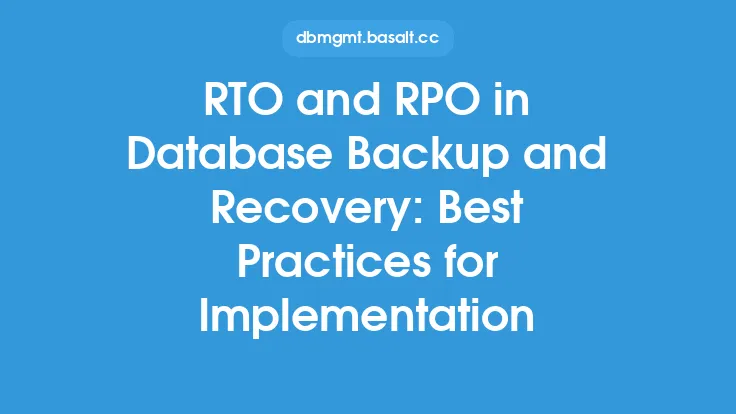Standardizing database backup and recovery procedures is a critical aspect of database administration, as it ensures the integrity and availability of data in the event of a failure or disaster. A well-planned and executed backup and recovery strategy can help minimize data loss, reduce downtime, and ensure business continuity. In this article, we will delve into the importance of standardizing database backup and recovery procedures, the key components of a comprehensive backup and recovery plan, and the best practices for implementing and maintaining these standards.
Introduction to Database Backup and Recovery
Database backup and recovery procedures are designed to protect data from loss or corruption due to hardware or software failures, human errors, or natural disasters. A backup is a copy of the data stored in a database, which can be used to restore the data in case of a failure. The recovery process involves restoring the data from the backup to a consistent state, ensuring that the data is accurate and reliable. Standardizing database backup and recovery procedures involves establishing a set of guidelines and protocols that ensure consistency, reliability, and efficiency in the backup and recovery process.
Key Components of a Comprehensive Backup and Recovery Plan
A comprehensive backup and recovery plan should include the following key components:
- Backup Strategy: Define the type of backups to be performed, such as full, incremental, or differential backups, and the frequency of each type.
- Backup Media: Specify the media to be used for storing backups, such as tape, disk, or cloud storage.
- Backup Schedule: Establish a schedule for performing backups, including the time of day, day of the week, and frequency.
- Data Retention: Define the retention period for backups, including how long backups will be kept and when they will be deleted.
- Recovery Procedures: Document the procedures for recovering data from backups, including the steps to be taken in the event of a failure.
- Testing and Validation: Regularly test and validate the backup and recovery process to ensure that it is working correctly and that data can be recovered successfully.
Best Practices for Implementing and Maintaining Backup and Recovery Standards
To ensure the effectiveness of database backup and recovery procedures, the following best practices should be implemented and maintained:
- Automate Backup Processes: Automate backup processes to ensure consistency and reduce the risk of human error.
- Use Versioning: Use versioning to track changes to the database and ensure that backups are consistent with the current state of the database.
- Test Backup and Recovery: Regularly test backup and recovery procedures to ensure that they are working correctly and that data can be recovered successfully.
- Monitor Backup and Recovery: Monitor backup and recovery processes to detect any issues or errors and take corrective action.
- Document Backup and Recovery Procedures: Document backup and recovery procedures to ensure that they are well understood and can be followed in the event of a failure.
- Train Personnel: Train personnel on backup and recovery procedures to ensure that they are aware of their roles and responsibilities.
Technical Considerations for Database Backup and Recovery
When implementing database backup and recovery procedures, several technical considerations must be taken into account, including:
- Database Type: The type of database being used, such as relational or NoSQL, can impact the backup and recovery process.
- Database Size: The size of the database can impact the backup and recovery process, with larger databases requiring more time and resources to backup and recover.
- Data Distribution: The distribution of data across multiple servers or locations can impact the backup and recovery process, requiring more complex procedures to ensure data consistency.
- Backup Tools: The choice of backup tools, such as native database tools or third-party tools, can impact the backup and recovery process, with some tools offering more features and functionality than others.
- Recovery Time Objective (RTO): The RTO, which is the amount of time allowed for recovery, can impact the backup and recovery process, with shorter RTOs requiring more frequent backups and faster recovery procedures.
Common Challenges and Solutions
Common challenges encountered when implementing and maintaining database backup and recovery procedures include:
- Data Growth: Rapid data growth can impact the backup and recovery process, requiring more frequent backups and larger storage capacity.
- Complexity: Complex database environments, such as those with multiple servers or locations, can make it difficult to implement and maintain backup and recovery procedures.
- Human Error: Human error, such as forgetting to perform backups or incorrectly configuring backup procedures, can impact the backup and recovery process.
- Technical Issues: Technical issues, such as hardware or software failures, can impact the backup and recovery process, requiring prompt attention to resolve.
Solutions to these challenges include implementing automated backup processes, using versioning and testing to ensure data consistency, and providing training to personnel on backup and recovery procedures.
Conclusion
Standardizing database backup and recovery procedures is essential for ensuring the integrity and availability of data in the event of a failure or disaster. By establishing a comprehensive backup and recovery plan, implementing best practices, and considering technical factors, organizations can minimize data loss, reduce downtime, and ensure business continuity. Regular testing and validation of backup and recovery procedures, as well as ongoing monitoring and maintenance, are critical to ensuring the effectiveness of these procedures. By prioritizing database backup and recovery, organizations can protect their data and ensure the continued operation of their business.
